Akividu / Akiveedu (my home town) - Include posts/articles of history, human stories, politics, religion and science.
Don't wanna be here? Send us removal request.
Text
All-Star Moments in Space Communications and Navigation
How do we get information from missions exploring the cosmos back to humans on Earth? Our space communications and navigation networks – the Near Space Network and the Deep Space Network – bring back science and exploration data daily.
Here are a few of our favorite moments from 2024.

1. Hip-Hop to Deep Space
The stars above and on Earth aligned as lyrics from the song “The Rain (Supa Dupa Fly)” by hip-hop artist Missy Elliott were beamed to Venus via NASA’s Deep Space Network. Using a 34-meter (112-foot) wide Deep Space Station 13 (DSS-13) radio dish antenna, located at the network’s Goldstone Deep Space Communications Complex in California, the song was sent at 10:05 a.m. PDT on Friday, July 12 and traveled about 158 million miles from Earth to Venus �� the artist’s favorite planet. Coincidentally, the DSS-13 that sent the transmission is also nicknamed Venus!

NASA's PACE mission transmitting data to Earth through NASA's Near Space Network.
2. Lemme Upgrade You
Our Near Space Network, which supports communications for space-based missions within 1.2 million miles of Earth, is constantly enhancing its capabilities to support science and exploration missions. Last year, the network implemented DTN (Delay/Disruption Tolerant Networking), which provides robust protection of data traveling from extreme distances. NASA’s PACE (Plankton, Aerosol, Cloud, ocean Ecosystem) mission is the first operational science mission to leverage the network’s DTN capabilities. Since PACE’s launch, over 17 million bundles of data have been transmitted by the satellite and received by the network’s ground station.
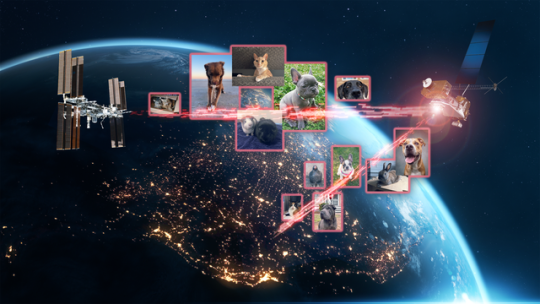
A collage of the pet photos sent over laser links from Earth to LCRD and finally to ILLUMA-T (Integrated LCRD Low Earth Orbit User Modem and Amplifier Terminal) on the International Space Station. Animals submitted include cats, dogs, birds, chickens, cows, snakes, and pigs.
3. Who Doesn’t Love Pets?
Last year, we transmitted hundreds of pet photos and videos to the International Space Station, showcasing how laser communications can send more data at once than traditional methods. Imagery of cherished pets gathered from NASA astronauts and agency employees flowed from the mission ops center to the optical ground stations and then to the in-space Laser Communications Relay Demonstration (LCRD), which relayed the signal to a payload on the space station. This activity demonstrated how laser communications and high-rate DTN can benefit human spaceflight missions.

4K video footage was routed from the PC-12 aircraft to an optical ground station in Cleveland. From there, it was sent over an Earth-based network to NASA’s White Sands Test Facility in Las Cruces, New Mexico. The signals were then sent to NASA’s Laser Communications Relay Demonstration spacecraft and relayed to the ILLUMA-T payload on the International Space Station.
4. Now Streaming
A team of engineers transmitted 4K video footage from an aircraft to the International Space Station and back using laser communication signals. Historically, we have relied on radio waves to send information to and from space. Laser communications use infrared light to transmit 10 to 100 times more data than radio frequency systems. The flight tests were part of an agency initiative to stream high-bandwidth video and other data from deep space, enabling future human missions beyond low-Earth orbit.

The Near Space Network provides missions within 1.2 million miles of Earth with communications and navigation services.
5. New Year, New Relationships
At the very end of 2024, the Near Space Network announced multiple contract awards to enhance the network’s services portfolio. The network, which uses a blend of government and commercial assets to get data to and from spacecraft, will be able to support more missions observing our Earth and exploring the cosmos. These commercial assets, alongside the existing network, will also play a critical role in our Artemis campaign, which calls for long-term exploration of the Moon.

On Monday, Oct. 14, 2024, at 12:06 p.m. EDT, a SpaceX Falcon Heavy rocket carrying NASA’s Europa Clipper spacecraft lifts off from Launch Complex 39A at NASA’s Kennedy Space Center in Florida.
6. 3, 2, 1, Blast Off!
Together, the Near Space Network and the Deep Space Network supported the launch of Europa Clipper. The Near Space Network provided communications and navigation services to SpaceX’s Falcon Heavy rocket, which launched this Jupiter-bound mission into space! After vehicle separation, the Deep Space Network acquired Europa Clipper’s signal and began full mission support. This is another example of how these networks work together seamlessly to ensure critical mission success.

Engineer Adam Gannon works on the development of Cognitive Engine-1 in the Cognitive Communications Lab at NASA’s Glenn Research Center.
7. Make Way for Next-Gen Tech
Our Technology Education Satellite program organizes collaborative missions that pair university students with researchers to evaluate how new technologies work on small satellites, also known as CubeSats. In 2024, cognitive communications technology, designed to enable autonomous space communications systems, was successfully tested in space on the Technology Educational Satellite 11 mission. Autonomous systems use technology reactive to their environment to implement updates during a spaceflight mission without needing human interaction post-launch.

A first: All six radio frequency antennas at the Madrid Deep Space Communication Complex, part of NASA’s Deep Space Network (DSN), carried out a test to receive data from the agency’s Voyager 1 spacecraft at the same time.
8. Six Are Better Than One
On April 20, 2024, all six radio frequency antennas at the Madrid Deep Space Communication Complex, part of our Deep Space Network, carried out a test to receive data from the agency’s Voyager 1 spacecraft at the same time. Combining the antennas’ receiving power, or arraying, lets the network collect the very faint signals from faraway spacecraft.
Here’s to another year connecting Earth and space.
Make sure to follow us on Tumblr for your regular dose of space!
1K notes
·
View notes
Text
426 notes
·
View notes
Text

Just here to share the Italian judo winner kissing her girlfriend after the match, in front of our fascist, homophobic, disgusting prime minister.
We won this one🏳️🌈
Credits to: @apriteilcervello on instagram
74K notes
·
View notes
Text
13 notes
·
View notes
Text

It's my 16 year anniversary on Tumblr 🥳
0 notes
Text

CAPITOL CRIMES: The US Capitol is where the Senate and House of Representatives come together to discuss, debate and deliberate national policy; develop consensus; and craft the country's laws, many of which have been designed to establish/maintain supremacy on the basis of race, gender, and/or class.
📍Flushing Ave bet. Washington & Waverly
39 notes
·
View notes
Photo

Vincent van Gogh, Wheat Fields after the Rain, 1890, oil on canvas Carnegie Museum of Art, Pittsburgh, PA
10K notes
·
View notes
Text
13 notes
·
View notes
Text
Open Letter to Ocasio-Cortez
I wrote to the member of the House of Representatives of the U.S. Alexandria Ocasio-Cortez but discovered that you have to live in a certain area to be able to email her, which may or may not be the case with representatives in general (I have not checked). I am not living in her district, so I am publishing my letter openly instead. Dear Congresswoman Ocasio-Cortez:
You have been an inspiration for many who have been following you. However, your recent baffling position on Ukraine has been a major disappointment. Inexplicably, in a tweet since deleted, you first wrote that sanctions against Russia should not hurt Ukrainian people. Then came your vote forming a curious left / extreme right and highly unfortunate caucus against using the money of Russian oligarch for the needs of Ukraine that Russia attacked. You offered no public justification for this vote of yours.
Your vote is puzzling for those who have been studying the Russian colonialism and following the Russo-Ukrainian war since 2014. I would like to bring it to your attention that the Russian colonialism is not any more virtuous than the U.S. colonialism.
With sadness I learned that the Western left tends to believe that Ukraine is under the influence of the Ukrainian far right or even that the American imperialism supplying the said right with weapons for the benefit of military industrial complex. It is difficult to say whether you are of these opinions because you have not explained your vote. Even should we believe that the inner politics in Ukraine is headed into the wrong direction, it is still the Ukrainian inner politics. France and the U.S., where the far right ideas are also extremely popular, are not in a danger of justification of foreign aggression against them from the Western critics.
Should we trust that the inner Ukrainian politics is dictated by the collective West (the highly questionable idea denying agency to Ukraine and its ability to know what’s best for it), the internationally recognized borders of the sovereign Ukraine were defined from the time of the collapse of the USSR and should be respected.
Russia has been an aggressor against those borders, against the sovereignty of Ukraine, and indeed against the very existence of the Ukrainian people as a nation. Denial of Ukraine’s very existence is widely spread in the Russian state media. The result of this state ideology we observed in the massacre of Bucha, the scene of genocidal violence that does not emerge unless the aggressor dehumanized the victim.
The name of this town became a shorthand for half a dozen of similar massacres since revealed (other locations include Irpin, Gostomel, Borodyanka, adding to horrors Russia unleashed in Mariupol). Many more “Buchas” are to be revealed in the future on the Ukrainian territories currently occupied by Russia.
At this time the minimum we can agree on is that Russia needs to recognize the internationally recognized borders of Ukraine and its right to self-determination, Russia needs to stop its war of aggression against Ukraine, and Russia needs its troops to leave Ukraine.
Russia is an aggressor against a sovereign state of Ukraine breaking away from the Russian colonialism. Anti-colonialism and anti-imperialism need to include the anti-Russian-colonialism, not be constrained to the anti-U.S. colonialism.
Ukraine has its democratically elected officials who are widely supported throughout the country. We should trust them to present the country’s vision for the future and not deny agency to Ukraine who has been struggling for its independence from Russia for decades and has had such devastating pages in history as Holodomor and now, Bucha.
Now Holodomor can become global if Russia isn’t defeated and continues ravaging Ukraine. The possibility of the worldwide famine is a concern of Congresswoman Ilhan Omar, who also voted so infelicitously with you, a handful of other Democrats, and a group of far-right Republicans forming the unfortunate caucus I mentioned. Her concern, among others, is equally important consideration that should bolster the support for the heavy weapons for Ukraine and harsher sanctions for Russia so that Ukraine can deter the Russian aggression as soon as possible.
We have an aggressor here, and this aggressor is Russia. The sooner Russia is decisively defeated, the sooner Ukraine and Russia alike can begin to return to the production of the wheat and crops with which these two countries supply the world. The conversation about lifting sanctions can be started only after the decisive defeat of Russia fixed in a set of ironclad conditions.
Implying that Ukraine must be defeated at no cost for Russia with a lift of sanctions is an offensive position poorly veneered by the concern for the consumers of goods with no regard as to how dear the production of these goods will be for the Ukrainians. It is a position reeking of consumerism regardless of the sincerity of care for the countries threatened with hunger in a very real way. Ukrainians should no more be made to pay with their blood and loss of their sovereignty for the sake of the African consumers of Ukrainian and Russian crops than Ukrainians should be made to pay with their blood for the comfort of European consumers of Russian oil and gas.
Only more heavy weapons for Ukraine and more sanctions for Russia can speed up the end of this war in which Russia must be defeated decisively. Only the Russian defeat in the war of aggression that seeks to erase the very existence of Ukraine as a state and a nation can spell the establishment of the long-term peace.
Please reconsider your position regarding Russian aggression against Ukraine. I urge you to disclose considerations you had that led you to your unfortunate vote so that the public can engage with your reasoning in essence.
Best, Vasilina Orlova, Ph.D.
20 notes
·
View notes
Text
1K notes
·
View notes
Text
Our Parker Solar Probe Just Touched the Sun!

For the first time in history, a spacecraft has touched the Sun. Our Parker Solar Probe flew right through the Sun’s atmosphere, the corona. (That’s the part of the Sun that we can see during a total solar eclipse.)
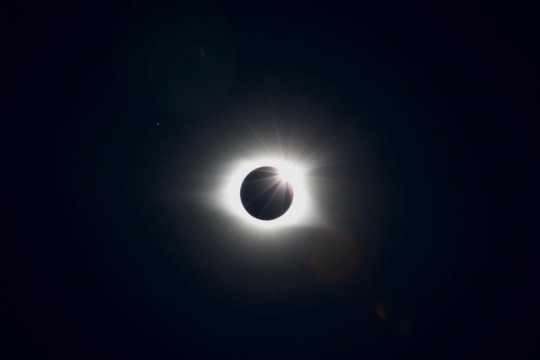
This marks one great step for Parker Solar Probe and one giant leap for solar science! Landing on the Moon helped scientists better understand how it was formed. Now, touching the Sun will help scientists understand our star and how it influences worlds across the solar system.
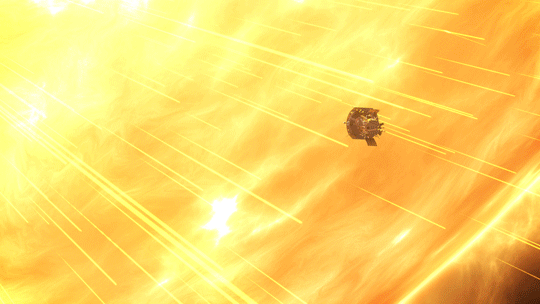
Unlike Earth, the Sun doesn’t have a solid surface (it’s a giant ball of seething, boiling gases). But the Sun does have a superheated atmosphere. Heat and pressure push solar material away from the Sun. Eventually, some of that material escapes the pull of the Sun’s gravity and magnetism and becomes the solar wind, which gusts through the entire solar system.
But where exactly does the Sun’s atmosphere end and the solar wind begin? We’ve never known for sure. Until now!

In April 2021, Parker Solar Probe swooped near the Sun. It passed through a massive plume of solar material in the corona. This was like flying into the eye of a hurricane. That flow of solar stuff — usually a powerful stream of particles — hit the brakes and went into slow-motion.
For the first time, Parker Solar Probe found itself in a place where the Sun’s magnetism and gravity were strong enough to stop solar material from escaping. That told scientists Parker Solar Probe had passed the boundary: On one side, space filled with solar wind, on the other, the Sun’s atmosphere.
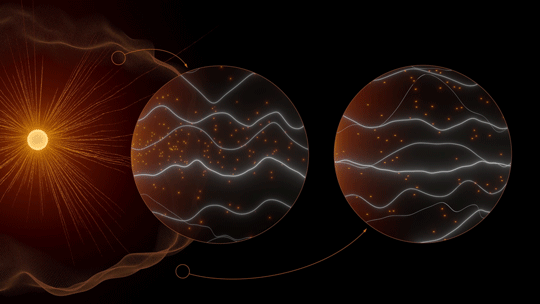
Parker Solar Probe’s proximity to the Sun has led to another big discovery: the origin of switchbacks, zig-zag-shaped magnetic kinks in the solar wind.
These bizarre shapes were first observed in the 1990s. Then, in 2019, Parker Solar Probe revealed they were much more common than scientists first realized. But they still had questions, like where the switchbacks come from and how the Sun makes them.

Recently, Parker Solar Probe dug up two important clues. First, switchbacks tend to have lots of helium, which scientists know comes from the solar surface. And they come in patches.
Those patches lined up just right with magnetic funnels that appear on the Sun’s surface. Matching these clues up like puzzle pieces, scientists realized switchbacks must come from near the surface of the Sun.
Figuring out where switchbacks come from and how they form will help scientists understand how the Sun produces the solar wind. And that could clue us into one of the Sun’s biggest mysteries: why the Sun’s atmosphere is much, much hotter than the surface below.
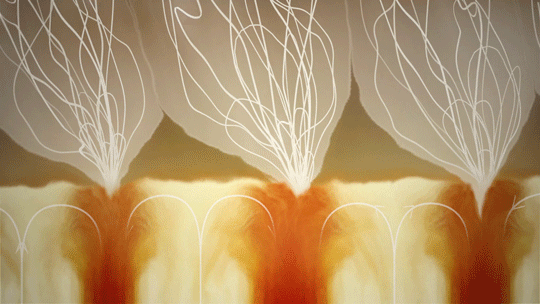
Parker Solar Probe will fly closer and closer to the Sun. Who knows what else we’ll discover?
Make sure to follow us on Tumblr for your regular dose of space!
5K notes
·
View notes
Photo

White Ash Tree
Watercolor on paper
Size - 9.5" X 7"
25 notes
·
View notes
Text
Our Parker Solar Probe Just Touched the Sun!

For the first time in history, a spacecraft has touched the Sun. Our Parker Solar Probe flew right through the Sun’s atmosphere, the corona. (That’s the part of the Sun that we can see during a total solar eclipse.)

This marks one great step for Parker Solar Probe and one giant leap for solar science! Landing on the Moon helped scientists better understand how it was formed. Now, touching the Sun will help scientists understand our star and how it influences worlds across the solar system.

Unlike Earth, the Sun doesn’t have a solid surface (it’s a giant ball of seething, boiling gases). But the Sun does have a superheated atmosphere. Heat and pressure push solar material away from the Sun. Eventually, some of that material escapes the pull of the Sun’s gravity and magnetism and becomes the solar wind, which gusts through the entire solar system.
But where exactly does the Sun’s atmosphere end and the solar wind begin? We’ve never known for sure. Until now!

In April 2021, Parker Solar Probe swooped near the Sun. It passed through a massive plume of solar material in the corona. This was like flying into the eye of a hurricane. That flow of solar stuff — usually a powerful stream of particles — hit the brakes and went into slow-motion.
For the first time, Parker Solar Probe found itself in a place where the Sun’s magnetism and gravity were strong enough to stop solar material from escaping. That told scientists Parker Solar Probe had passed the boundary: On one side, space filled with solar wind, on the other, the Sun’s atmosphere.

Parker Solar Probe’s proximity to the Sun has led to another big discovery: the origin of switchbacks, zig-zag-shaped magnetic kinks in the solar wind.
These bizarre shapes were first observed in the 1990s. Then, in 2019, Parker Solar Probe revealed they were much more common than scientists first realized. But they still had questions, like where the switchbacks come from and how the Sun makes them.

Recently, Parker Solar Probe dug up two important clues. First, switchbacks tend to have lots of helium, which scientists know comes from the solar surface. And they come in patches.
Those patches lined up just right with magnetic funnels that appear on the Sun’s surface. Matching these clues up like puzzle pieces, scientists realized switchbacks must come from near the surface of the Sun.
Figuring out where switchbacks come from and how they form will help scientists understand how the Sun produces the solar wind. And that could clue us into one of the Sun’s biggest mysteries: why the Sun’s atmosphere is much, much hotter than the surface below.

Parker Solar Probe will fly closer and closer to the Sun. Who knows what else we’ll discover?
Make sure to follow us on Tumblr for your regular dose of space!
5K notes
·
View notes








